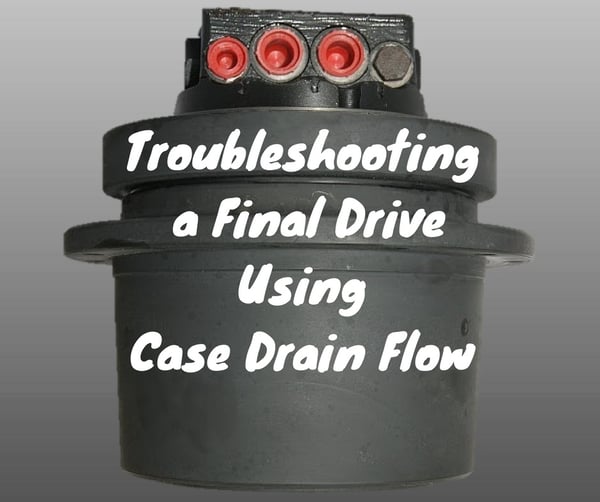
One way to troubleshoot a final drive that seems weak is to take a look at the rate of flow from the case drain line. In this Shop Talk Blog post, we are going to review the purpose of a case drain line, look at what case drain flow can tell us about a final drive, and then discuss how to estimate the case drain flow. We'll finish up by looking at how to evaluate the case drain flow to determine if the problem is your final drive.
Purpose of Case Drain Flow
The case drain line drains internal leakage from the hydraulic motor back to the hydraulic tank. The case drain should experience minimal flow and low pressure. Keep in mind that there will always be some level of internal leakage expected. All piston-type hydraulic motors will leak hydraulic fluid from the rotator group. This is a good type of leak: it lubricates the piston shoes, the swash or thrust plate, and the area between the cylinder block and the valve plate.
Excessive Case Drain Flow
When a final drive is damaged or badly worn, however, there will be more internal leakage. This excessive leakage will negatively impact the performance of the final drive and can be the cause of a lack of power. If there is too much leakage, it can be detected by monitoring the flow from the case drain line.
Measuring the Case Drain Flow
Your machine’s manual should have information on the expected rate of case drain flow. If it doesn’t, you can compare the rate of flow from the “good” final drive to that of the “weak” final drive. Now, we know that most people don’t have a case flow meter--but you can still get a fair estimate of the flow rate without it. What you need to do is run the case drain flow into a small container of known size and run a timer until it is full. From that, you can estimate the gpm of case drain flow.

Evaluating the Case Drain Flow
If the rate of case drain flow is greater than it should be, then there is a good probability that you have a problem with that final drive. Examples of too much case drain flow would be flow that is greater on the “bad” side than the “good” side, more than what the manufacturer specifies, or more than a very slow rate of flow). If your final drive's case drain flow is too much, it should be serviced before things get any worse. On the other hand, if the case drain flow is within normal parameters, then the problem is probably not going to be your final drive and you need to keep investigating.
Conclusion
Investing the case drain flow from a final drive or travel motor can help when troubleshooting what seems to be a weak final drive or travel motor. Just keep in mind that it's important to investigate all the possibilities before deciding the cause is your final drive motor.
Texas Final Drive is your partner in providing new or remanufactured final drive hydraulic motors from a single mini-excavator to a fleet of heavy equipment. Call today so we can find the right final drive or hydraulic component for you, or check out our online store to find your O.E.M. manufacturer brand motor now.
Learn about how clogged case drain filters can destroy your final drive in this shocking eBook!


